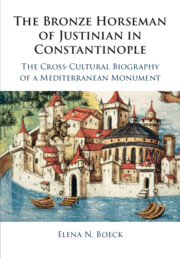 The Bronze Horseman of Justinian in Constantinople
The Bronze Horseman of Justinian in Constantinople Book contents
- The Bronze Horseman of Justinian in Constantinople
- The Bronze Horseman of Justinian in Constantinople
- Copyright page
- Contents
- Figures and Maps
- Tables
- Acknowledgements
- Abbreviations
- Note on Transliteration and Naming Conventions
- Selected Timeline of the Triumphal Column of Justinian and Its International Reverberations
- Map of Constantinople
- Introduction
- 1 Justinian’s Entry into Constantinople: He Came, He Saw, He Conquered
- 2 The Making of Justinian’s Forum
- 3 Defying a Defining Witness: the Bronze Horseman and the Buildings (De Aedificiis) of Prokopios
- 4 The Horseman of Baghdad Responds to the Horseman of Constantinople
- 5 Soothing Imperial Anxieties: Theophilos and the Restoration of Justinian’s Crown
- 6 Debating Justinian’s Merits in the Tenth Century
- 7 The Bronze Horseman and a Dark Hour for Humanity
- 8 The Horseman Becomes Heraclius: crusading Narratives of the Eleventh and Twelfth Centuries
- 9 From Exile in Nicaea to Restoration of Constantinople
- 10 A Learned Dialogue across the Ages: Pachymeres Confronts Prokopios
- 11 Orb-Session: Constantinople’s Future in the Bronze Horseman’s Hand
- 12 Justinian’s Column and the Antiquarian Gaze: a Centuries-Old “Secret” Exposed
- 13 A Timeless Ideal: Constantinople in Slavonic Imagination of the Fourteenth–Fifteenth Centuries
- 14 The Horseman Meets Its End
- 15 Horse as Historia, Byzantium as Allegory
- 16 Shadowy Past and Menacing Future
- 17 After the Fall: the Bronze Horseman and the Eternal Tsar’grad
- Postscript: the Horseman’s Debut in Print
- Select Bibliography
- Index
10 - A Learned Dialogue across the Ages: Pachymeres Confronts Prokopios
Published online by Cambridge University Press: 08 April 2021
- The Bronze Horseman of Justinian in Constantinople
- The Bronze Horseman of Justinian in Constantinople
- Copyright page
- Contents
- Figures and Maps
- Tables
- Acknowledgements
- Abbreviations
- Note on Transliteration and Naming Conventions
- Selected Timeline of the Triumphal Column of Justinian and Its International Reverberations
- Map of Constantinople
- Introduction
- 1 Justinian’s Entry into Constantinople: He Came, He Saw, He Conquered
- 2 The Making of Justinian’s Forum
- 3 Defying a Defining Witness: the Bronze Horseman and the Buildings (De Aedificiis) of Prokopios
- 4 The Horseman of Baghdad Responds to the Horseman of Constantinople
- 5 Soothing Imperial Anxieties: Theophilos and the Restoration of Justinian’s Crown
- 6 Debating Justinian’s Merits in the Tenth Century
- 7 The Bronze Horseman and a Dark Hour for Humanity
- 8 The Horseman Becomes Heraclius: crusading Narratives of the Eleventh and Twelfth Centuries
- 9 From Exile in Nicaea to Restoration of Constantinople
- 10 A Learned Dialogue across the Ages: Pachymeres Confronts Prokopios
- 11 Orb-Session: Constantinople’s Future in the Bronze Horseman’s Hand
- 12 Justinian’s Column and the Antiquarian Gaze: a Centuries-Old “Secret” Exposed
- 13 A Timeless Ideal: Constantinople in Slavonic Imagination of the Fourteenth–Fifteenth Centuries
- 14 The Horseman Meets Its End
- 15 Horse as Historia, Byzantium as Allegory
- 16 Shadowy Past and Menacing Future
- 17 After the Fall: the Bronze Horseman and the Eternal Tsar’grad
- Postscript: the Horseman’s Debut in Print
- Select Bibliography
- Index
Summary
For intellectuals of the re-conquest generation, Prokopios became a helpful guide to the city they had lost and regained. George Pachymeres (1242–ca. 1308), a highly placed court historian, engaged in an intertextual dialogue with the lengthy account of the horseman written by Prokopios. Pachymeres set out to write an exemplary ekphrasis that would outperform Prokopios in vivid explication of Justinian’s monument. The narrative structure follows Prokopios, but emphasizes different points. Pachymeres created a narrative contrast between the Constantinople of his own days and the glorious Constantinople of earlier times by focusing on the horseman – the tangible imperial link that threaded together two eras. The narrative offered by Pachymeres provides a lens through which we can behold the experience of an intellectual returning from exile and a learned observer examining a monument of a glorious past. His extended description of the monument sought to reconstruct its creator’s reasoning by using his own powers of observation, thus addressing a failure of Prokopios. Pachymeres can therefore be considered an eager, early pioneer of the fertile terrain that is now known as "late antique studies."
Keywords
- Type
- Chapter
- Information
- The Bronze Horseman of Justinian in ConstantinopleThe Cross-Cultural Biography of a Mediterranean Monument, pp. 216 - 232Publisher: Cambridge University PressPrint publication year: 2021


